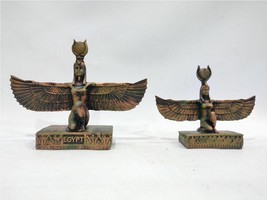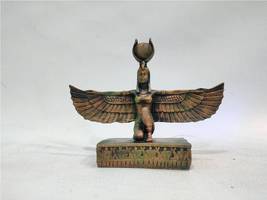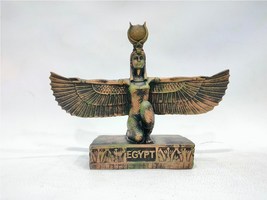Rendered at 16:42:17 04/25/25
The unique Egyptian goddess Isis. With open wings, Isis stone in ancient copper
£48.85 GBP
Ships from
Egypt

Shipping options
£18.78 to United Kingdom
Ships from
Egypt

Return policy
Refunds available: See booth/item description for details
Details
Purchase protection
Payment options
PayPal accepted
PayPal Credit accepted
Venmo accepted
PayPal, MasterCard, Visa, Discover, and American Express accepted
Maestro accepted
Amazon Pay accepted
Nuvei accepted
Shipping options
£18.78 to United Kingdom
Ships from
Egypt

Return policy
Refunds available: See booth/item description for details
Details
Purchase protection
Payment options
PayPal accepted
PayPal Credit accepted
Venmo accepted
PayPal, MasterCard, Visa, Discover, and American Express accepted
Maestro accepted
Amazon Pay accepted
Nuvei accepted
Item traits
| Category: | |
|---|---|
| Quantity Available: |
2 in stock |
| Condition: |
Unspecified by seller, may be new. |
Listing details
| Seller policies: | |
|---|---|
| Shipping discount: |
Free shipping on orders over $300.00 |
| Price discount: |
10% off w/ $100.00 spent |
| Posted for sale: |
More than a week ago |
| Item number: |
1642729793 |
Item description
Brand. Pr Nefrt
made in egypt
Isis is a major goddess in the ancient Egyptian religion whose worship spread throughout the Greco-Roman world. Isis is mentioned for the first time in the ancient kingdom of Egypt (2686-2181 BC) as one of the main characters in the Osiris myth, as she resurrected her husband, the slain divine king Osiris, and gave birth to his heir Horus and protected him. Isis was believed to guide the dead to the afterlife, as she helped Osiris, and she was considered the divine mother of the Pharaoh as he was likened to her son Horus. Her maternal aid consisted in a healing spell to aid the common people. Originally, Isis played a small role in royal hymns and in temple rituals and rituals, but was more important in burial rites and magical texts. In art, she was often represented as a female human wearing a kind of throne on her head. During the New Kingdom, the characteristics of Hathor - the former prominent goddess - took on the form of Isis, who wore the clothes of Hathor, and on her head the sun disk between the horns of a cow, as Hathor was previously represented.
In the first millennium BC, Isis and Osiris became the most worshiped Egyptian deities, and Isis absorbed many of the features of other deities. The rulers of Egypt and the rulers of its neighbors south in Nubia began building temples dedicated to Isis, and her temple at Philae was one of the most important religious centers for Egyptians and Nubians alike. Isis's magical powers were stronger than all the other gods, and it was said that she protected the kingdom from its enemies, to rule the heavens and the natural world, and to rule over the same destiny.
The cult of Isis ended with the spread of Christianity in the fourth and fifth centuries AD. Her worship influenced beliefs and practices, but the evidence for this influence remains vague and has much disagreement. Isis continued to appear in Western culture, especially in Western esoteric teachings and in neo-paganism, often as a personification of nature or the feminine aspect of divinity.
While some Egyptian deities appeared in the last pre-dynastic period (before 3100 BC), both Isis and her husband Osiris were not clearly mentioned before the Fifth Dynasty (2494-2345 BC). A manuscript of this period refers to Isis. From the era of King Ni User-Ra, as Isis appears clearly in the texts of the pyramids, which began writing at the end of the family although its content must have developed long before this. Many phrases in the texts of the pyramids connect Isis to the Nile Delta region near Behbeit al-Hajjar and Samanoud, as her worship often began there.
Many researchers have focused on the name Isis in an effort to determine its origin. Its Egyptian name was ?st or ?Ast?, from which the Coptic name ?Assi? (in the Coptic language:), and from it Isis (Greek:), which is the name from which the modern name is derived. The hieroglyphic name includes the sign of a throne, which Isis also wears on her head as a sign of her identity. The symbol serves as a phoneme, as it forms part "six" of her name, but it may also be associated with the actual throne. The name of the throne in the Egyptian language was "Set" as well, and he may have shared the term with the name of Isis. So Egyptologist Kurt Sethi suggests that Isis was initially a personification of thrones.
Isis is part of the Ennead, a family of nine deities, all descended from the creator god Atum, or Ra. Isis, Osiris, West, and Nephthys are the last of the ninth generation, born from the pit of the earth god and Nut the goddess of the sky. The creator god, the ruler of the original world, passed his authority over the male generations of the Ennead until Osiris became king.
In the evolving form of myth, Isis gives birth to Horus after a long pregnancy and a difficult birth on a papyrus pond in the Nile Delta. As her son grew, she had to protect him from six and many other dangers, such as snakes, scorpions, and simple diseases.
Isis continued to help her son when he challenged Set to regain his throne, which Six had robbed of his father. Despite the occasional disagreement between the son and his mother to the point that Horus cut off his mother?s head and had to replace her head with a cow?s head, the original legend says that Isis wore two cow horns on her head. Since the beginning.
In Egyptian art, Isis was often depicted in the image of a woman with the attributes of the typical gods: a thin dress and a bundle of papyrus in one hand and the sign of life ankh in the other. Her original headdress was a throne which is also used in writing her name. Often Isis and Nephthys appear together, especially when denouncing Osiris's death or placing him on his throne, or when protecting coffins. In these circumstances, their hands are often at their heads in a sign of denunciation, or they are extended around Osiris or the dead as a sign of their role in protecting him.
Isis also took a picture of a tree or woman overflowing from a tree, sometimes providing food and water to the dead. This photo indicated the maternal feeding she is doing.
#F_W
Added to your wish list!

- The unique Egyptian goddess Isis. With open wings, Isis stone in ancient copper
- 2 in stock
- Returns/refunds accepted
Get an item reminder
We'll email you a link to your item now and follow up with a single reminder (if you'd like one). That's it! No spam, no hassle.
Already have an account?
Log in and add this item to your wish list.














